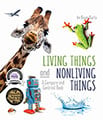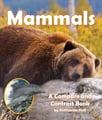| |
Living Things and Nonliving Things  |
Using a wide variety of stunning photographs, author Kevin Kurtz poses thought-provoking questions to help readers determine if things are living or nonliving. For example, if most (but not all) living things can move, can any nonliving things move? As part of the Compare and Contrast series, this is a unique look at determining whether something is living or nonliving. This nonfiction picture book with a cuddle factor includes a 4-page For Creative Minds section in the back of the book and a 30-page cross-curricular Teaching Activity Guide online. Living Things and Nonliving Things is vetted by experts and designed to encourage parental engagement. Its extensive back matter helps teachers with time-saving lesson ideas, provides extensions for science, math, and social studies units, and uses inquiry-based learning to help build critical thinking skills in young readers. The Spanish translation supports ELL and dual-language programs. The interactive ebook reads aloud in both English and Spanish with word highlighting and audio speed control to promote oral language skills, fluency, pronunciation, text engagement, and reading comprehension. Tap animals and other things that make noise to hear their sounds. Written by Kevin Kurtz
32 pg, 8.5 X 10, Ages 4-8, Grades K-3, Lexile: AD 470, F&P: L
| |
|
|
|
|
|
| Keywords: compare and contrast, living and nonliving, sort, checklist, |
|
| Animals in the book: polar bear, eagle, orangutan, cheetah, whale, fox, mule, tiger, bison, elephant |
|
| Vetters: Thanks to Lennie Dusek, Early Childhood Specialist at the Museum of Discovery in Little Rock, AR for verifying the accuracy of the information in this book. |
|
Books in this "Compare and Contrast Series" include:











Reviews:
Statements and questions in the large-print text lead smoothly from one double-page spread to the next, while well-chosen color photos illustrate the text. These appealing images show up beautifully on the heavy, glossy pages. An appended section includes a series of small photos beside boxes briefly listing the benchmarks that will help the reader decide whether the pictures represent living or nonliving things. An intriguing, well-designed book with classroom potential. — Carolyn Phelan
-Booklist
The photos are all stock images but they are bright, clear, and kid-friendly. An ending “For Creative Minds† section was developed for classroom use. Consider for early STEM collections, to be used in a guided setting.
- School Library Journal
Vivid photographs featuring some of Earth’s most astonishing features, creatures, and accomplishments are set on a crisp white backdrop and paired with an array of questions that sensibly guide curious young biologists on a quest of scientific identification in Living Things and Nonliving Things: A Compare and Contrast Book from Kevin Kurtz.
- Foreword Reviews
Author/Illustrator Info:

Award-winning author Kevin Kurtz holds degrees in English literature and elementary education and started his career by working at a marine biology lab. Since then, he has combined all of these experiences by working as an environmental educator and curriculum writer for organizations such as the South Carolina Aquarium, the Science Factory Children's Museum, and the Center for Birds of Prey. Kevin has authored A Day in the Deep, A Day on the Mountain, and A Day in the Salt Marsh for Arbordale. Kevin also wrote Uncovering Earth's
Secrets after spending eight weeks as the Educator at Sea aboard the marine geology research vessel JOIDES Resolution. Visit Kevin's website for more information.
|
| |
|